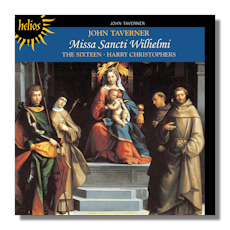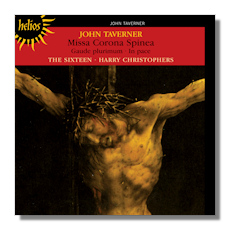
The Internet's Premier Classical Music Source
Related Links
- Taverner Reviews
- Latest Reviews
- More Reviews
-
By Composer
-
Collections
DVD & Blu-ray
Books
Concert Reviews
Articles/Interviews
Software
Audio
Search Amazon
Recommended Links
Site News
 CD Review
CD Review
John Taverner

Masses
- Motet "O Wilhemi, pastor bone"
- Motet "Dum transisset Sabbatum" II
- Mass "Missa Sancti Wilhelmi"
- Motet "Ex eius tumba"
The Sixteen/Harry Christophers
Hyperion Helios CDH55055 51:40


- Motet "Gaude plurinum"
- Mass "Missa Corona Spinea"
- Motet "In pace"
The Sixteen/Harry Christophers
Hyperion Helios CDH55051 58:41
Summary for the Busy Executive: Must-haves for choral fans.
Given today's information glut on no-talent "celebrities," it strikes me as grossly unfair that we know so little about great artists. However, then as now, most people simply escaped official notice, which is overwhelmingly the kind of notice that has survived. We can at least name the Pharaohs, but not the architects of the pyramids. Consequently, we know less about the Tudor composer John Taverner than we do about Cardinal Wolsey, his patron, and about as much for sure as about Shakespeare – ie, not much.
At any rate, Taverner's contemporaries must have thought highly of his music, despite the lack of written reviews, since he was appointed the choirmaster of Oxford's Cardinal College (now Christchurch), founded by Wolsey himself, the wealthiest man in England, who spared no expense. The choir consisted of a whopping 28 voices, pretty sumptuous for the time. Based on the music that has survived, most familiar with the period argue for Taverner as the finest English composer of his era (middle Tudor), the only one that seems comparable to the great Flemish masters of the period: Ockeghem, Obrecht, and Josquin, called by his contemporaries "the prince of music."
I got into Renaissance music mainly through performing works by the English madrigal school – composers like Morley, Wilbye, Weelkes, Byrd, Gibbons, and basically any composer who appeared in the collection The Triumphs of Oriana. However, I learned quickly that a huge pile of great music lay beyond not only the madrigal, but beyond England.
The solid core of the repertory consists of the motets and masses, mainly by the Flemish school. However, our notions of expressivity have changed over the centuries. For example, most of us probably fail to notice, unless we actually see a production, the seduction in the music of Don Giovanni's "Là ci darem" after the supercharged eroticism Tristan und Isolde. Thus, omitting a few exceptional very dramatic composers indeed, we miss in Renaissance music, despite its beauty, an immediate emotional jolt. A bit of "thinking ourselves back" seems required. Taverner isn't an especially dramatic artist, like Byrd or, much later, Monteverdi and Gesualdo, but he is a monumental one. Apparently, we've lost most of his output, but pure masterpiece remains. Again, he is the only British composer of his time whose work you can reasonably set alongside Josquin's .
The works on these CDs divide into mainly two types: masses; motets snd prayers. Immediately, the sheer beauty of the vocal lines and the virtuosic choral "orchestration" (the particular combination of voices) hit you, particularly in the masses with mixtures of full choir, duos (known as the "English style"), and trios. "Gaude plurimum" (rejoice greatly), an antiphon to Mary, uses the orchestration expressively. It begins with a spare two voices and gradually grows to a climax on the full voices about half-way through, as the reasons for rejoicing pile up. The texture again reduces to two voices, and the same process begins, culminating on a gloriously florid imitative "Amen." Some of the prayers alternate plainchant with full polyphony, as in "Ex eius tumba" (from his tomb – about the miraculous healing oil exuded by the tomb of St. Nicolas). The Missa Sancti Wilhelmi is a parody mass, meaning that the composer has based the mass on a previous polyphonic composition – in this case, Taverner's own prayer "O Wilhelme, pastor bone" (O William, good shepherd). The borrowings show up in the Gloria and in the Agnus Dei, with the other movements freely composed. According to the English custom of the time, the Kyrie was sung in plainchant and thus not composed by Taverner. Indeed, I know of only one Kyrie setting by Taverner, and it may or may not belong to a complete mass setting. Missa Corona spinea ("crown of thorns") is an even more elaborate score than Sancti Wilhelmi, a "festal mass," with six vocal parts. The sopranos routinely take to the stratosphere. The vocal combinations are often unusual. Instead of combining just high voices or just low voices (what I'd call "block" voicing), Taverner comes up with, for instance, a texture consisting of bass, baritone, and soprano.
It takes a masterful choral group to bring this music off. Harry Christophers and the Sixteen offer perfect blend and intonation, lines that stretch beyond the horizon, and a slightly bright tone, ideal for clarifying the full counterpoint. These releases, part of The Sixteen's Taverner series and on a slightly cheaper Hyperion label, should appeal both to Renaissance aficionados and to fans of great choral singing.
Copyright © 2014, Steve Schwartz





















